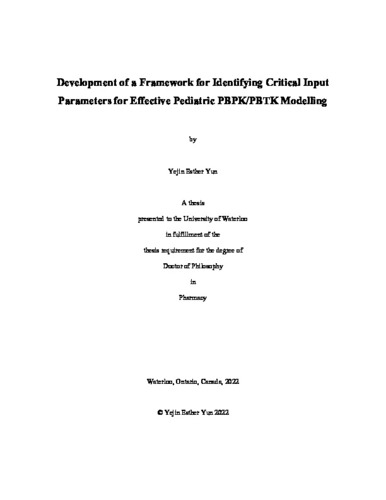| dc.description.abstract | Within a physiologically based pharmacokinetic (PBPK) model framework, virtual children are built based on known trajectories of anatomy and physiology across age and a compounds transfer within the body is defined by physicochemical and biochemical properties. Pediatric PBPK models have been used to derive doses for pediatric clinical trials and to assess risk of exposure to environmental chemicals. The identification of critical system- and compound-specific input parameters for pediatric PBPK modeling is crucial to applying this approach where pharmacokinetic (PK) data are limited. The objective of this study is to suggest a framework for the development of effective pediatric PBPK models by (i) identifying the most critical input parameters affecting the model precision as a means of targeting experimentation and by (ii) developing a workflow that combines available in silico prediction methods to estimate PK parameters in children. It is hypothesized that the framework for pediatric PBPK modeling will decrease the uncertainty associated with human health risk assessment in children.
Pediatric PBPK models for 10 hepatically metabolized compounds were developed and their predictive performance was evaluated by comparing the predicted and observed PK values in children. Resonable prediction accuracy was demonstrated such that eighty-one percent of the comparisons between simulated and observed clearance values were within two-fold error. Through sensitivity analyses, the most important parameters for pediatric PBPK modeling were identified. It was found that protein binding and clearance parameters were important for pediatric PBPK models. In light of these findings, prediction methods of plasma protein binding and clearance in children were chosen as the main topics of this dissertation.
When experimentally determined plasma protein binding information is not available, quantitative structure–property relationship (QSPR) models can be used to predict fraction unbound in plasma (fup) in humans. Three available QSPR models were evaluated. The most important chemical descriptors for predicting fup were lipophilicity, positive polar surface area, and the number of basic functional groups. It was found that the prediction of fup was the most uncertain for highly bound compounds. The next step was to evaluate adult-to-children scaling algorithms (ontogeny models) for fup. The predictive performance of 4 ontogeny models for albumin and 5 ontogeny models for alpha1-acid glycoprotein (AAG) were evaluated. Plasma protein concentrations vs. age profiles derived from non-linear equations (PK-Sim and Johnson et al.) were more in agreement with the observed levels than other models. Prediction accuracy of the ontogeny model depended on the appropriateness of the protein concentration vs. age profiles of ontogeny models particularly for highly bound compounds.
For environmentally relevant compounds which are data-poor (e.g. information on physicochemical, toxicokinetic, and toxicological properties is not available), the prediction accuracy for fup prediction in children (fupchild) can be different than pharmaceuticals where experimental data such as fup in adults (fupadult) is often available. The prediction of fupchild for data-limited scenarios were evaluated with data-rich compounds such as pharmaceuticals as fupchild values are often available for those compounds. When QSPR-predicted fup in adult values were used as an input for predicting fupchild, over-predictions were observed for acids and neutrals with an average fold error (AFE) up to 8. The results indicated that an experimental determination of fup in adults was crucial.
Two methods were proposed for predicting clearance (CL) in children from compound structure. The workflow utilizes QSPR models, protein binding ontogeny models and virtual pediatric individuals. Hepatic intrinsic CL, renal CL and fup in adults were estimated from a compound structure based on QSPR methods. Appropriate scaling methods were used to estimate CL in children. The QSPR-predicted CL values showed an over-prediction with geometric mean fold error values ranging from 1.9 to 3.29. When a predominant clearance pathway (e.g. hepatic metabolism or renal excretion) was predicted based on physicochemical properties of compounds and this information was used for CL prediction in children, the prediction accuracy was improved. The proposed workflow is considered to provide a reasonable estimation of clearance in pediatric population for human health risk assessment for data-sparse compounds.
Prediction of dermal absorption in children is an important aspect in human health risk assessment. A pediatric dermal absorption model was developed by incorporating maturation functions into a MoBi implementation of the Dancik et al. 2013 skin permeation model.
Adult models were first developed by optimizing key chemical specific parameters using the observed dermal absorption data in adults (e.g. in vitro permeation testing experimentation). For predicting dermal absorption in children, chemical-specific parameters in the model remained the same as in the adult model and age-dependent components of dermal absorption (e.g., skin layer thickness and hydration) were scaled as a function of age. This model can be used to predict dermal absorption in children by taking into account the physicochemical properties of the drug and the maturation of skin physiology and anatomy. In order to incorporate the information on the maturation of skin physiology and anatomy, extensive literature search was conducted. The predictive performance of the model was evaluated by comparing predicted and observed rate of dermal absorption for three compounds where IVPT data were available for neonates. The model described the trend of increased flux in neonates compared to adults. The predicted flux values were similar to the observed and predicted mean flux in neonates generally fell within the 90 percent prediction intervals. More IVPT data in children are required for model evaluation, however, the preliminary assessment with the limited set of data demonstrated favourable outcome.
The studies in this dissertation evaluated computational methods that can be used to estimate pediatric PK for data-sparse compounds (e.g. environmentally relevant compounds). The proposed workflows and developed models for estimating important PK parameters in children in this dissertation are considered to be useful in decreasing uncertainties associated with PK in children estimation from compound structure for environmentally relevant compounds. Furthermore, the proposed models are physiologically relevant and these models will help risk assessors to make informed decisions for human health risk assessment in children. | en |

